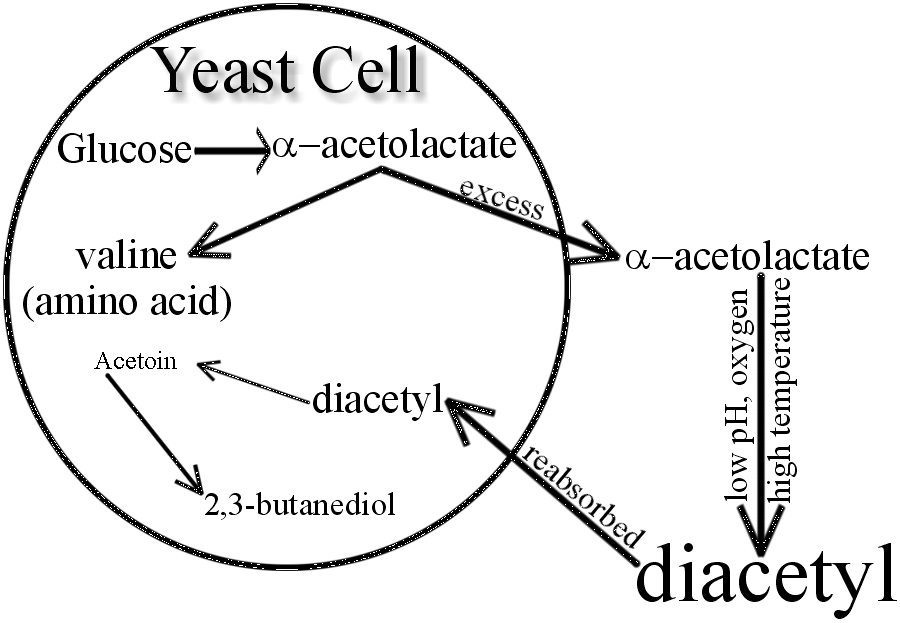Technical Note
Down With Diacetyl,
or
Banish Buttery Butanedione!
Diacetyl, formally a “vicinal diketone” known as 2,3-butanedione, is a natural by-product of fermentation. It is detectable in beer at concentrations as low as fifty parts per billion. At low levels, it gives beer a slick mouthfeel; at higher levels, the flavor becomes buttery — diacetyl is in fact what they make artificial butter out of — then like butterscotch, and eventually downright rancid. First I'll let you know where the diacetyl comes from, and then I'll tell you how to get it out of your beer.
One possible source of diacetyl is bacterial infection. Pediococcus and Lactobacillus are notoriously prodigious producers of diacetyl. So it's always a good idea to review your sanitation procedures; if you've got other problems like sourness, “rope”, and other nasty off-aromas, infection may very well be your problem.
As I said, diacetyl is also a natural by-product of the fermentation of wort by brewing yeast. The following diagram illustrates how yeast produce diacetyl, and how they clean it up. If the diagram looks frightening, don't worry; just skip down to “What to do about it”. Otherwise, stand by for the gory details.

Brewing yeast convert glucose to ethanol via a very intricate metabolic pathway. One by-product that occurs along the way is an ester called α-acetolactate. The cell can use some of this ester to produce valine, an amino acid. The rest of the α-acetolactate gets dumped into your beer. That wouldn't be much of a problem, except that in beer's low pH environment, α-acetolactate gets transformed into diacetyl, which we've already established is a Bad Thing. Oxygen helps that reaction along, as do elevated fermentation temperatures. So once you separate the yeast from the beer, if there's still α-acetolactate, you're going to get diacetyl and there's nothing you can do about it.
But all is not lost! Given time, when the yeast is done with its fermentation work, it will actually re-absorb the diacetyl from the beer. Higher temperatures accelerate this process. Once it's back in the cell, the diacetyl is converted into acetoin and subsequently into 2,3-butanediol. A by-product of each of those conversions is a compound called NAD+, which helps the cell produce energy. The end result is that the diacetyl is no longer in your beer, and the by-products of the cleanup effort have flavor thresholds so high they're not worth worrying about.
What to do about it: You're not going to believe how simple this is. Do a “diacetyl rest”; that is, leave your beer in the fermenter for two or three days after it looks like the fermentation is complete. That's it. That will give the yeast time to clean up the diacetyl they've produced. If you're brewing an ale, the fermentation temperature is already high enough that the cleanup will proceed rather quickly. If you're brewing a lager, try this trick: start allowing the fermentation temperature to rise once the beer has fermented to half its original gravity. By that point, you're far enough into the fermentation that the yeast aren't going to generate any more “ale” characters (such as fruity esters) and you've still got enough time to let the temperature rise to a useful level, say, 65°F. Maintain this temperature until the diacetyl is gone or until the end of fermentation, whichever is later, then rack for lagering.
How can you tell if the diacetyl rest is complete? There's an easy “forcing” test that will only cost you a few ounces of beer. Pull a sample from your fermenter and split it into two covered containers. Refrigerate one and heat the other to 140°F for an hour, then taste them both. If they taste the same, you're ready to rack your beer out of the fermenter. If you can taste butter in the heated sample, your yeast is still at work, and you should give it another day or two.
Contrary to what the BJCP Style Guidelines might imply, beers without diacetyl taste a lot better than beers with diacetyl. Try this experiment: walk down the popcorn aisle at your local grocery store and take a deep breath. Do you want your beer to taste like that? I didn't think so. And now you know what to do about it.
- Richard Stueven
for the Green Bay Rackers newsletter
April 2003
